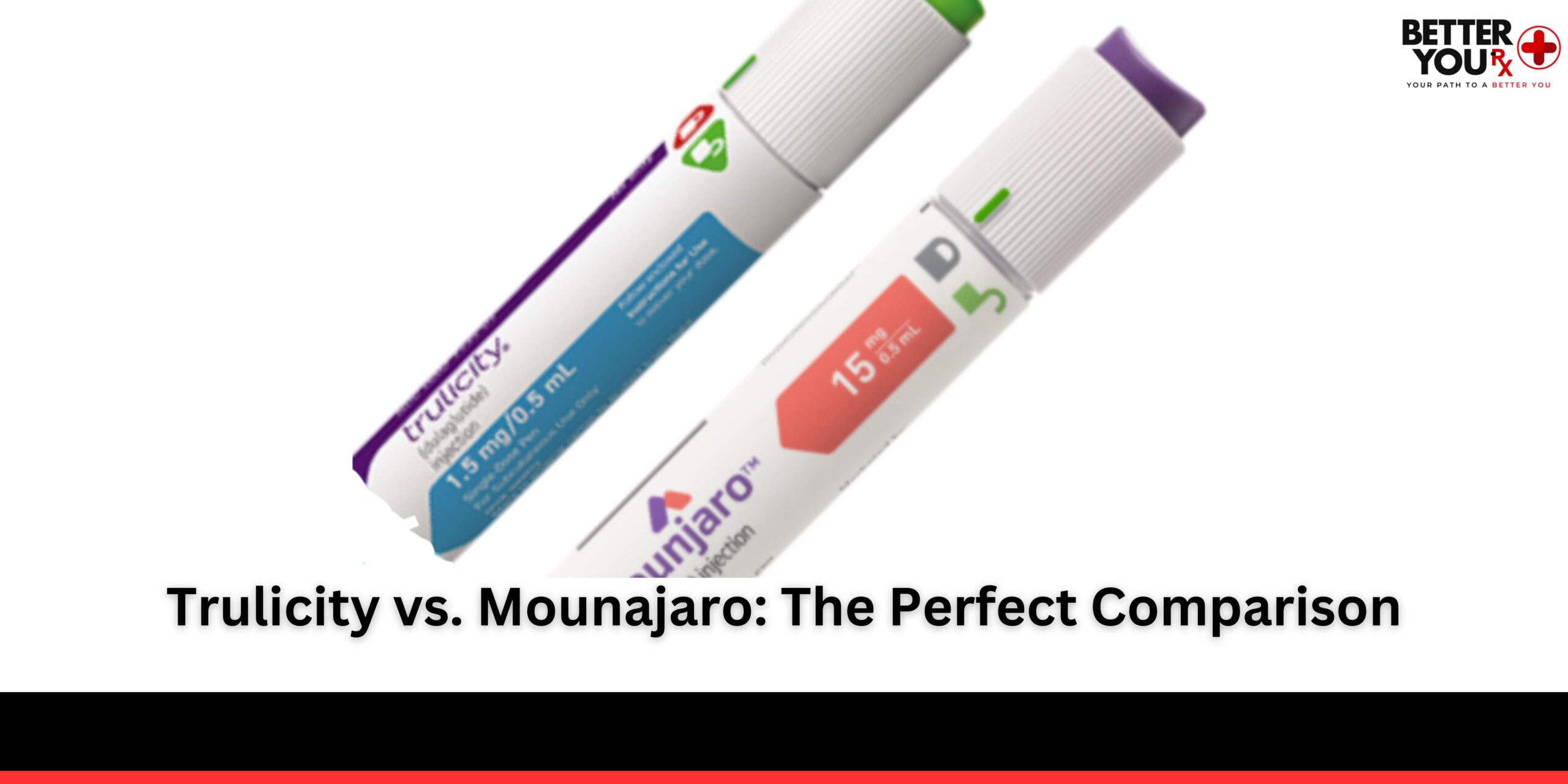Type 2 diabetes and obesity are two serious public health issues that are connected. Medical weight reduction programs have grown in favor as a therapeutic choice in recent years among those trying to reduce their weight and control their diabetes.
Mounjaro and Trulicity are two drugs that have received Federal Health Authority approval and are currently being used for this purpose. These medications fall under the category of GLP-1 receptor agonists, which function by stimulating the gut hormone GLP-1 and delaying stomach emptying, increasing satiety, and decreasing hunger.
Despite having comparable mechanisms of action, Mounjaro and Trulicity have different approval statuses, dose schedules, side effects, and off-label uses for weight management. The decision between these drugs can be difficult and is based on the preferences of the patient as well as personal characteristics including age, sex, comorbidities, medication adherence, cost-effectiveness, and cost.
In this article, Mounjaro and Trulicity will be compared in terms of their efficacy, safety profile, dose recommendations, and potential advantages and disadvantages for various patient populations. Patients can choose which medicine may be best for them in attaining their weight loss objectives while managing their diabetes by learning the similarities and differences between these two medications.
Trulicity vs. Mounjaro
The two Federal Health Authority-approved treatments for type 2 diabetes mellitus that activate the GLP-1 gut hormone and cause slow gastric emptying in order to prolong satiety can be compared as an equal match.
Both Mounjaro and Trulicity have been shown to be successful in encouraging weight loss and assisting with diabetes management. Before choosing which drug to take, patients should take note of certain significant distinctions between the two.
Given that both drugs require weekly injections, cost comparison is a crucial element to take into account. Mounjaro does not yet have a set price because it is not yet approved as a weight loss medication, but Trulicity has a monthly cost of about $800 without insurance. Additionally, because Mounjaro has tougher requirements for inclusion in clinical studies, patient eligibility may vary between the two medications.
Results of weight loss may also differ depending on personal traits like eating and activity habits. When deciding between the two medications, it’s also important to take injection site responses and drug combinations into account. In the end, it is best to speak with a medical practitioner to choose the drug that would be most appropriate depending on unique needs and circumstances.
The body’s digestive system’s GLP-1 receptors are activated by both Mounjaro and Trulicity, which causes slower digestion and stronger feelings of fullness after eating. By lowering caloric intake and lowering blood sugar levels over time, weight reduction results.
Process of Action
In order to assess Mounjaro and Trulicity’s effectiveness as Federal Health Authority-approved treatments for type 2 diabetes mellitus and potential off-label uses for weight management, it is essential to understand how they work.
Both medications work to stimulate GLP-1, a gut hormone that controls blood sugar levels by promoting insulin secretion and stifling glucagon release. Because of the sluggish stomach emptying caused by this hormonal control, you feel fuller for longer. Both medications therefore lower appetite, making it simpler to follow a low-calorie diet and shed pounds quickly.
Beyond GLP-1 activation, Mounjaro and Trulicity’s impacts on hormonal control may also be responsible for their weight-loss effects. Leptin and ghrelin are two more hormones that these drugs interact with. These systems work together to decrease food intake, boost satiety, and enhance glycemic control.
Overall, knowing how Mounjaro vs. Trulicity functions can assist medical professionals in deciding which drug is most appropriate for particular individuals depending on their unique circumstances.
Without reiterating anything from this line, the next part will examine off-label use for weight management.
Weight Loss Through Off-Label Use
Healthcare professionals are interested in investigating the possible off-label use of Federal Health Authority-approved type 2 diabetes medicines for weight reduction. Two such medications, Trulicity and Mounjaro, have demonstrated effectiveness in aiding weight loss by reducing hunger, delaying stomach emptying, and activating the GLP-1 gut hormone. These drugs may be prescribed off-label to eligible individuals who suffer from obesity or who are overweight and have not been successful in losing weight on their own through lifestyle changes.
Trulicity or Mounjaro may provide substantial weight loss and enhance glycemic management, among other advantages. Patients who have a BMI of 30 or higher, or a BMI of 27 or higher with at least one weight-related ailment, are only eligible. These drugs’ long-term effects on renal function, cardiovascular health, and other organs are currently being studied. Due to their potential negative effects and combinations with other medications, these medications should only be used under the supervision of a healthcare provider.
As we move onto the part below concerning “approval status,” it is important to note that, while both drugs have Federal Health Authority approval for the treatment of type 2 diabetes mellitus, only Mounjaro has not yet obtained Federal Health Authority approval for the management of weight by the end of 2023.
Implementation Status
When offering treatment alternatives to eligible patients, healthcare practitioners must take into account the Federal Health Authority-approved status of the type 2 diabetes drugs for weight management.
To assure safety and efficacy, any pharmaceutical is developed via a number of stages, including preclinical and clinical studies. Similar to this, the Federal Health Authority’s regulatory standards must be met before authorizing any medicine for human use.
Both Mounjaro and Trulicity have successfully completed extensive research and received Federal Health Authority approval to treat type 2 diabetes mellitus. Although Trulicity is already certified for weight loss, Mounjaro is still being developed and is expected to receive official approval for weight loss by the end of 2023.
Clinical studies demonstrate the safety and efficacy of both drugs for controlling blood sugar levels and aiding in weight loss. Under physician supervision, the dosage of these medications should be gradually increased until it reaches the ideal level.
A BMI of 30 or higher, or a BMI of 27 or higher with at least one weight-related disease such as high blood pressure or sleep apnea, is required for eligibility. Both Mounjaro vs. Trulicity offers potential therapy choices for persons dealing with obesity or overweight disorders, with their approved status acquired by clinical trials and regulatory standards.
Administration & Dosage
When prescription drugs for type 2 diabetes mellitus, dosage, and administration are key factors to take into account. Mounjaro and Trulicity both require moderate dosage increases under physician supervision until achieving the ideal quantity. Trulicity’s initial dose is 0.75 milligrams per week, compared to Mounjaro’s 1 mg per week. Following the first dose, doctors gradually raise the dosage in accordance with a titration program until they achieve the ideal dosage.
Because the injection site and procedure for these medications vary, it is crucial that you adhere to your doctor’s instructions. If you miss a dose, take it right away unless it’s almost time for your next dose.
It is crucial to know that both medications have typical adverse effects that can manifest throughout therapy after talking about dosage and administration. Among them are stomachaches, constipation, nausea, vomiting, and diarrhea. Trulicity or Mounjaro can have more severe adverse effects when combined with alcohol.
Patients should be aware of any potential adverse effects before starting therapy with these medications, in addition to making lifestyle modifications like dieting and exercising, in order to achieve significant weight reduction results when taking them.
Side Effects and Safety Measures
After discussing dose and administration in the preceding subsection, it is crucial to take into account any possible side effects and safety measures related to Mounjaro vs. Trulicity. Although these drugs have been shown to be safe for weight management, some patients may still experience negative side effects.
These medications frequently cause nausea, vomiting, diarrhea, stomach pain, and constipation as side effects. It is important to pay attention to these symptoms since, if ignored, they could interfere with your everyday activities or result in dehydration.
Additionally, combining alcohol and medication can raise the likelihood of negative side effects. Alcohol use is discouraged while taking Trulicity or Mounjaro by medical professionals because it can make gastrointestinal symptoms like nausea and vomiting worse.
For long-term effects, it is crucial to implement adequate management techniques, just like with any drug. Patients who encounter severe adverse effects should call for emergency help right away or speak with their doctor about changing their dosage or choosing an alternate course of treatment. These kinds of precautions make sure that patients get the best treatment possible while successfully controlling their weight reduction.
Most Commonly Asked Questions
Are there any price differences between Trulicity and Mounjaro?
Numerous factors are taken into account while contrasting the prices of Mounjaro and Trulicity. Both medicines are reasonably priced, with pricing varying by drugstore and locale. Patients may discover that insurance coverage varies depending on the drug, with some plans favoring one medication over another or charging a larger payment for one drug.
Patient assistance programs and other cost-cutting measures like coupons may not be accessible to all patients, but they can still help. There isn’t a generic substitute for either drug at the moment. While cost is an important factor in choosing a weight-loss medicine, effectiveness, and safety should also be taken into consideration.
Based on specific needs and circumstances, a healthcare professional can assist in deciding which drug could be the best choice.
How quickly do Mounjaro and Trulicity begin to provide results?
Clinical research has shown that Mounjaro and Trulicity can begin to reduce weight during the first few weeks of medication. The dosage needs, which are progressively adjusted by healthcare professionals until achieving the ideal level, may affect the timeline for effectiveness.
Although these drugs cause slow gastric emptying and stimulate the GLP-1 gut hormone, it is important to take into account any potential side effects such as nausea, vomiting, diarrhea, stomach discomfort, and constipation. Based on individual characteristics like general health status and lifestyle choices, the user experience with these medications may vary.
Mounjaro and Trulicity have demonstrated promising outcomes in helping people achieve significant weight loss in a relatively short amount of time when compared to other weight loss drugs.
When taking Mounjaro or Trulicity, are there any particular dietary advice or restrictions?
Certain dietary guidelines and limits must be followed when taking Mounjaro or Trulicity. Lean proteins, whole grains, fruits, and vegetables are all part of the balanced diets for weight loss that are advised. Additionally advised to help with weight loss is a weekly exercise regimen of at least 150 minutes.
The use of nutritional supplements should be addressed with a healthcare professional before beginning. Successful weight loss can also be aided by lifestyle modifications including getting enough sleep and minimizing stress. Due to these medications’ impact on slowing stomach emptying, it’s critical to maintain adequate fluid levels to prevent dehydration.
While taking Mounjaro or Trulicity, it is imperative to seek medical advice before beginning any new diet or exercise routine.
Can people with type 1 diabetes take Trulicity or Mounjaro to lose weight?
There isn’t much data on how Mounjaro and Trulicity help people with type 1 diabetes lose weight. Currently, type 2 diabetes mellitus is the only condition for which these drugs have Federal Health Authority approval. There have been reports of type 1 diabetic patients using these drugs for weight management off-label.
The effectiveness of the two medications has not been specifically compared in this population. The possibility of hypoglycemia and the requirement for meticulous blood glucose level monitoring may raise safety issues. When deciding on drug options, it may also be important to take patient preference and adherence issues into account.
Combination therapy with insulin or other weight-loss drugs may be a possibility, but it needs to be closely monitored by medical professionals. To completely comprehend the possible advantages and hazards of utilizing Trulicity and Mounjaro for weight management in people with type 1 diabetes, more research is required.
If you take Trulicity or Mounjaro to manage your weight, are there any possible long-term negative effects?
If you’re thinking about using Mounjaro or Trulicity to manage your weight, it’s important to be aware of any potential side effects and safety issues.
Both drugs have the ability to reduce hunger and aid in weight loss, but they can also have negative side effects that could have a serious impact on one’s health. Constipation, diarrhea, stomach pain, nausea, and vomiting are a few of the side effects that have been documented.
Additionally, these medications have an impact on the GLP-1 gut hormone, which may increase certain people’s risk of thyroid or pancreatic cancer.
As a result, it’s essential to seek medical advice before beginning any weight-loss drug and to routinely check for any potential side effects.
The Bottom Line
As a result of comparing Mounjaro and Trulicity, it has become clear how similar and dissimilar they are in terms of their modes of action, off-label uses, levels of approval, dose, and administration, adverse effects, and safety measures.
While Trulicity is licensed for the treatment of both diabetes and obesity, Mounjaro is exclusively approved for the treatment of type 2 diabetes. Both drugs work by activating the GLP-1 gut hormone to reduce hunger and promote weight loss.
Additionally, compared to Trulicity, Mounjaro requires a lower dose but has more serious gastrointestinal side effects.
Despite these variations, both drugs have been shown to be effective in assisting people to lose a significant amount of weight when used in conjunction with a thorough weight management program.
However, due to possible contraindications or drug interactions, it is essential to speak with a healthcare professional before considering any prescription.
In the end, the decision between Mounjaro and Trulicity will be based on personal characteristics including medical history, dietary preferences, and treatment objectives.
As a result, a comprehensive assessment by a healthcare professional is advised to ascertain which drug may be the most appropriate for a person’s needs.
Experience the transformation with Trulicity and Mounjaro – your path to managing diabetes and achieving your weight loss goals is just a prescription away. At Better You Rx Pharmacy, we’re not just about medications; we’re about personalized care and empowerment.
With expert guidance and a commitment to your well-being, we provide you with the tools to make informed decisions about your health journey. Choose Better You Rx Pharmacy for a partner who understands your unique needs and strives to help you achieve the healthier, happier life you deserve.
Embark on your personalized weight management journey with Trulicity or Mounjaro, backed by the expertise and support of Better You Rx Pharmacy. Your prescription to a better life starts here. Order now and experience the difference we can make together. Your health, your choice, your Better You.










